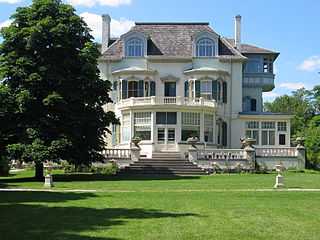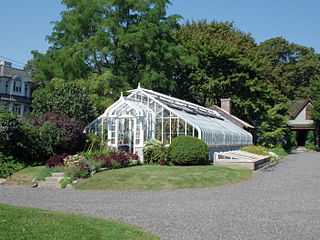Spadina House
| Spadina House | |
|---|---|
 Spadina House (2004) | |
| General information | |
| Type | Three Storey House |
| Location |
285 Spadina Road Toronto, Canada |
| Construction started | 1866 |
| Completed | 1913 |
| Design and construction | |
| Architect |
Unknown (1866) Vaux Chadwick (1896)[1] Eustace Bird (1905-1912) |
Spadina House, also called Spadina Museum, is a historic manor on Spadina Road in Toronto, Canada that is now a museum operated by the City of Toronto Cultural Services.[2] The museum preserves the house much as it existed and developed historically. The art, decor and architecture of the house used to reflect the contemporary styles of the 1860s through the 1930s, including Victorian, Edwardian, Arts and Crafts, Art Deco, Art Nouveau and Colonial Revival styles.[1][3] After being closed for a year for restoration work, Spadina Museum re-opened in November 2010 in the inter-war era style of the 1920s and 1930s. The estate's gardens reflect the landscape during the Austin family's occupation of the house.
History
The first house constructed on the site was built in 1818 by Dr. William Warren Baldwin. He named his 200-acre (0.81 km2) property and estate Spadina, which derived from the native word espadinong, which translates as "hill" or "sudden rise of land".[4][5] Baldwin himself designed the two storey wood frame house. The house burnt down in 1835, and owing to the three mile (5 km) trek from the estate into York, he moved to a house on Front Street. He built a smaller country estate on the property in 1836.
In 1866 the property was acquired by James Austin, founder of The Dominion Bank and Consumers Gas.[4] By this time, parts of the property had been sold off, and what Austin purchased covered 80 acres (320,000 m2).[5] In the 19th and early 20th century the area was the wealthiest in Toronto, with a number of Toronto's leading families having large estates. Austin subdivided and sold off the land west of Spadina Road in 1889, which amounted to 40 acres (160,000 m2). In 1892, James Austin turned over the house, and 20 acres (81,000 m2) of the property to his son, Albert William Austin. Albert Austin expanded the house in several renovations, including the addition of a third floor in 1912.[6] He sold much of the property to the City of Toronto in 1913 for the construction of the St. Clair Reservoir. Albert Austin died in 1933.
The last member of the family to live in the house was Anna Kathleen Thompson, a daughter of Albert Austin, who lived there from 1942 until 1982.[7] The aged house had outdated wiring and needed a thorough overhaul, that would have been far more expensive than rebuilding it. While the house could have been sold to private interests, the family decided instead to donate the house and all of its furnishings to the city.[6] In 1984 it opened as a museum, jointly owned by the city and the Ontario Heritage Foundation and operated by the City of Toronto. The museum is especially known for its gardens.
-
Spadina House (2005)
-

Spadina House (2007)
-
.jpg)
Spadina House (2007)
-
Billiard room, Spadina House (2006)
-

Spadina House greenhouse (2012)
Location
The house is at the southern end of the northern section of Spadina Road, on top of Davenport Hill, an escarpment which was the shore of prehistoric Lake Iroquois. Immediately east was Sir John Craig Eaton and Lady Eaton's massive Italianate palace and estate, Ardwold. Just around the corner on Austin Terrace, on the lot adjacent to Spadina House, is Casa Loma, a stately pile built in 1911 by Major-General Sir Henry Mill Pellatt.
Name
Many Torontonians follow a convention of pronouncing Spadina Road with the i as /aɪ/ as in mine, and Spadina House with the i as in /iː/ as in ski. Occasionally Spadina Road is pronounced the second way. South of Bloor Street, however, Spadina Road becomes Spadina Avenue, which is always pronounced the first way. The distinction between the two ways was once an economic class marker in Toronto with the upper classes favouring the second pronunciation. Now, however, even the official TTC stop announcements pronounce the i in Spadina as the one in mine.[8]
Awards
Spadina Museum was jointly awarded the Peggi Armstrong Public Archaeology Award along with the Ontario Heritage Trust in 2004.[9]
Spadina Museum was awarded the Ontario Museum Association Award of Merit in conjunction with Dawn Roach Bowen for their Black History Month programme Meet Mrs. Pipkin in 2002.[10] Mrs. Pipkin was a laundress at the Spadina house in the 1860s, where she came after escaping slavery in the United States.
See also
References
- Thompson, Austin Seton. Spadina Story of Old Toronto Pagurian Press, 1975
- ↑ 1.0 1.1 "Spadina Museum: Historic House & Gardens". City of Toronto.
- ↑ "Spadina Historic House and Gardens (Spadina Museum)". City of Toronto.
- ↑ Karen Edwards (November 15, 2005). "Inaugural Artist in Residence Program exhibition at Spadina Museum". City of Toronto.
- ↑ 4.0 4.1 "Spadina". Toronto Green Community & Toronto Field Naturalists.
- ↑ 5.0 5.1 John H. Jameson Jr. and Sherene Baugher (April 18, 2007). "Adventures in Archaeology at the Ontario Heritage Trust". Springer New York.
- ↑ 6.0 6.1 "Historic Buildings of Toronto". Stillwater Productions.
- ↑ "Spadina Museum: Historic House and Gardens". Toronto Life.
- ↑ Jack Lakey (22nd Mars 2011). "The Fixer: They say Spa-deenah, but are they right?". Toronto Star. Check date values in:
|date=(help) - ↑ "2004 Recipient". Ontario Archaeological Society - Ottawa Chapter. November 16, 2006.
- ↑ "Culture Division receives two awards for outstanding museum programming". City of Toronto.
External links
| Wikimedia Commons has media related to Spadina House. |
| ||||||||||||||
Coordinates: 43°40′44″N 79°24′29″W / 43.679023°N 79.40815°W

